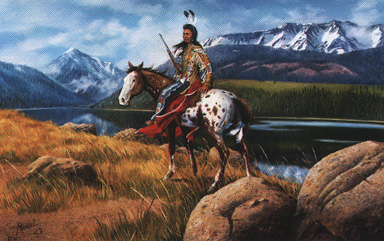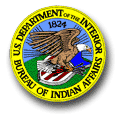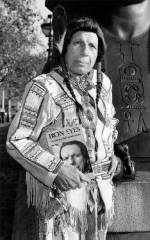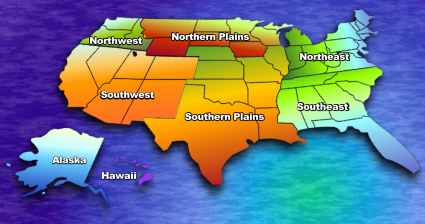|
|
|
|
Where Will Our Children Live...
A lonesome warrior stands in fear of what the future brings,
he will never hear the beating drums or the songs his brothers sing.
Our many nations once stood tall and ranged from shore to shore
but most are gone and few remain and the buffalo roam no more.
We shared our food and our land and gave with open hearts,
We wanted peace and love and hope, but all were torn apart.
All this was taken because we did not know what the white man had in store,
They killed our people and raped our lands and the buffalo roam no more.
But those of us who still remain hold our heads up high, and the spirits of
the elders flow through us as if they never died.
Our dreams will live on forever and our nations will be reborn, our bone and
beads and feathers all will be proudly worn.
If you listen close you will hear the drums and songs upon the winds, and in
the distance you will see....the buffalo roam again.
Submitted by Tommy Flamewalker Manasco


Native American Historical Documents
Native Americans Who Received the Nations Highest Honor - The Congressional Medal of Honor
Native Spirit Mother Earth Native Flute Mother Earth Native Flute Lone Wolf Indians First Amazing Grace in Native Language
LONG BEFORE the white man set foot on American soil, the American Indians, or rather the Native Americans, had been living in America. When the Europeans came here, there were probably about 10 million Indians populating America north of present-day Mexico. And they had been living in America for quite some time. It is believed that the first Native Americans arrived during the last ice-age, approximately 20,000 - 30,000 years ago through a land-bridge across the Bering Sound, from northeastern Siberia into Alaska. The oldest documented Indian cultures in North America are Sandia (15000 BC), Clovis (12000 BC) and Folsom (8000 BC)
Although it is believed that the Indians originated in Asia, few if any of them came from India. The name "Indian" was first applied to them by Christopher Columbus, who believed mistakenly that the mainland and islands of America were part of the Indies, in Asia.
So, when the Europeans started to arrive in the 16th- and 17th-century they were met by Native Americans, and enthusiastically so. The Natives regarded their white-complexioned visitors as something of a marvel, not only for their outlandish dress and beards and winged ships but even more for their wonderful technology - steel knives and swords, fire-belching arquebus and cannon, mirrors, hawkbells and earrings, copper and brass kettles, and so on.
However, conflicts eventually arose. As a starter, the arriving Europeans seemed attuned to another world, they appeared to be oblivious to the rhythms and spirit of nature. Nature to the Europeans - and the Indians detected this - was something of an obstacle, even an enemy. It was also a commodity: A forest was so many board feet of timber, a beaver colony so many pelts, a herd of buffalo so many robes and tongues. Even the Indians themselves were a resource - souls ripe for the Jesuit, Dominican, or Puritan plucking.
It was the Europeans' cultural arrogance, coupled with their materialistic view of the land and its animal and plant beings, that the Indians found repellent. Europeans, in sum, were regarded as something mechanical - soulless creatures who wielded diabolically ingenious tools and weapons to accomplish mad ends.
The Europeans brought with them not only a desire and will to conquer the new continent for all its material richness, but they also brought with them diseases that hit the Indians hard. Conflicts developed between the Native Americans and the Invaders, the latter arriving in overwhelming numbers, as many "as the stars in heaven". The Europeans were accustomed to own land and laid claim to it while they considered the Indians to be nomads with no interest to claim land ownership. The conflicts led to the Indian Wars, the Indian Removal Act empowered by President Andrew Jackson in 1830 and other acts instituted by the Europeans in order to accomplish their objectives, as they viewed them at the time. In these wars the Indian tribes were at a great disadvantage because of their modest numbers, nomadic life, lack of advanced weapons, and unwillingness to cooperate, even in their own defense.
The end of the wars more or less coincided with the end of the 19th century. The last major war was not really a war, it was a massacre in 1890 where Indian warriors, women, and children were slaughtered by U.S. cavalrymen at Wounded Knee, South Dakota, in a final spasm of ferocity.
A stupefying record of greed and treachery, of heroism and pain, had come to an end, a record forever staining the immense history of the westward movement, which in its drama and tragedy is also distinctively and unforgettably American.
Undersigned being an European emigrating to the U.S. during the latter part of the 20th century, cannot fully comprehend what happened during the past few centuries. I am sure many descendants of emigrants as well as many Native Americans feel the same way. We are all a product of our time and the circumstances prevalent at the time. If I had lived with the Europeans in America during the 19th century, would I have embraced what was going on then? If I had lived with the Germans in the 1930s and 40s, would I have embraced what was going on in Germany then? If I had lived in Scandinavia during medieval time witnessing the horrors of slavery and killings, would I have embraced what was going on then? (The Nordic countries practiced slavery during the middle ages, a master could for any reason kill his slave. Abolished in 1335)
These are hard questions for anyone to honestly answer. It is easy to toss around opinions now, at the end of the 20th century being conveniently removed from circumstances and conditions in a distant and foreign time.
This website will try to present as a true and accurate picture as possible of the past, but not dwell on it. However, it is important for one sole reason and that is to learn from the past and move into the 21st century as better human beings. After all, we are ONE people under God and we can only look back to the past as what it is - history. Now we attempt to cooperate to the best of our ability in the present and we are looking forward to the future for a better world. Let us once again cross the Bering land-bridge and sail the Mayflower, but this time together for the common goal of building up mutual respect and trust.
The best way to accomplish this goal, we believe, is for this website to contribute by presenting links to the most sincere, factual, reliable and honest web-sites around on this subject and let interested parties actively participate. We will try to cover all aspects of our common history in regards to the history and development of the west. You will find many Native American web-sites with an abundance of facts and sources of information here. Please join in if you think you have something to contribute!
National American Indian Heritage Month, 2004 Presidential Proclamation

 Biographies Indian Nations Natives Pow Wows Trail of Tears
Biographies Indian Nations Natives Pow Wows Trail of Tears

An Explanation of the Terms "Indian " and "Native American "
Reading through this website, you'll notice that most of the time we use the term "Native American" to describe the first inhabitants of this continent. Sometimes, however, we use the term "Indian. " While most scholars prefer to use Native American most of the time, sometimes the term "Indian" is more appropriate. Native Americans sometimes use the term "Indian" or "American Indian" to describe themselves. We often use terms like "Indian schools" or "Indian officials" for two reasons: one, because that is the language people at the time used, both Native Americans and whites, and two, these things are also often proper names or titles, as in the case of "Holy Childhood Indian School" or the "Bureau of Indian Affairs."
The Native American Tribes of the United States
Read the Indian Removal Act of 1830
Seminole-Negro Indian Scouts
Indian Wars Congressional Medal of Honor Recipients
Famous Chiefs - Red Cloud - Sitting Bull - Geronimo - Pontiac - Sequoyah
New - Incas
Abnaki |
Alabama Tribe |
Alaska Natives |
Aleuts |
Algonquin |
Ancestry |
Anasazi |
Apache |
Arapaho |
Arawak |
Arikara |
Art |
Assiniboin | Aztec |
Battles |
Beothuk |
Blackfeet |
Biographies |
Buffalo Soldiers |
Cabazon |
Caddo |
California |
Canadian Natives |
Catawba |
Census Info |
Cherokee |
Cheyenne |
Chickasaw |
Chief Joseph |
Chief Seattle |
Chinook |
Chippewa |
Choctaw |Chumash |
Code Talkers |
Comanche |
Councils & Institutes |
Cree |
Creek |
Crow |
Delaware |
Education |
Erie |
Eskimo |
Ethnology |
Family Life |
Famous |
Federations |
Five Civilized Tribes |
First Nation Mi'kMaq |
First Thanksgiving |
Flathead |
Gaming |
Genealogy |
Geronimo |
Haida |
Health Care |
Hidatsa |
History |
Hohokam |
Hopi |
Humor |
Hupa |
Huron |
Incas |
Illinois Tribe |
Ioway |Innu |
Inuit |
Indian Territory |
Intertribal Organizations |
Iroquois |
Iroquois Constitution |
Jim Thorpe |
Kaw |
Kickapoo |
Kiowa |
Klamath |
Kootenai |
Kwakiutl |
Languages |
Literature |
Little Big Horn |
Lore |
Mahican |
Makah |
Maliseet |
Mandan |
Mayan |
Melungeon |
Menominee |
Metis |
Miami Tribe |
Miracle, The White Buffalo |
Mission Indians |
Mississauga |
Modoc |
Mohave |
Mohawk |
Mohegan |
Montagnais |
Mound Builders | Music |
Narragansett |
Navajo |
Nations |
New Mexico |
Nez Perce |
Nootka |
Notable Native Women |
Ojibwe |
Olmec |
Omaha Tribe |
Oregon Tribes |
Osage |
Ottawa |
Oto |
Paiute |
Papago |
Passamaquoddy |
Pawnee |
Pennacook |
Penobscot |
Peoria |
Pequot |
Photos |
Pima |
Ponca |
Potawatomi |
| Powhatan |
Printed Stories |
Pueblo |
Pow Wows |
Quanah Parker |
Quapaw |
Quotes |
Radio |
Religion |
Recipes |
Resources |
Sacajawea |
Sac and Fox |
Sauk |
Seminole |
Seneca |
Shawnee |
Shoshone |
Shuswap |
Sioux |
Sites |
Southwest Tradition |
Southwest Tribes |
Spirituality |
Stand Watie |
Squanto |
Tecumseh |
Tlingit |
Toltec |
Tonkawa |
Trail of Tears |
Ute |
Washington |
Washo |
Wampanoag | Weapons |
Wichita |
Wigwams | Winnebago | Wovoka |
Wyandotte |
Yakima |Yuchi |
Yurok |
Zapotec |
Zuni
 The governing body for Native Americans in the United States.
The governing body for Native Americans in the United States.
In March of 1824, President James Monroe established the Office of Indian Affairs in the Department of War. Its mission was to conduct the nation's business with regard to Indian affairs. We have come together today to mark the first 176 years of the institution now known as the Bureau of Indian Affairs
Learn All About The Buffalo and What It Means To The Life & Survival of Native Americans

Listen to Iron Eyes Cody
See Colorful & Dramatic Native American Images In Our Galleries
Gallery 1 - Gallery 2 - Gallery 3 - Gallery 4 - Gallery 5 - Gallery 6 - Gallery 7
The Landing of Christopher Columbus 1492 - The Discovery of America
Learn all about the First Thanksgiving with the Pilgrims and The Mayflower
A Spanish Friar Indicts the Conquistadors for the Massacre of Indians (1542)
Father Andrew White's First Impressions of Maryland & Native Inhabitants (1634)
The Greatest American Athlete of the 1st Half of the 20th Century - Jim Thorpe
Native people and their cultural heritage, with emphasis on the traditional cultures of the Indigenous People of the Southwest by exhibiting the work of Carl Moon for the world on the internet. Carl E. Moon-- Vision Maker
Bibliography of Native North Americans
http://www.silverplatter.com/catalog/bnna.htm .
Native Health History Database
http://hsc.unm.edu/nhhd/ .
Native American Women Bibliography
http://www.radcliffe.edu/schles/libcolls/bksper/bibs/native.htm .
Ethnic Heritage: American Indian
http://www.cr.nps.gov/history/catsig/ethind.htm .
National Museum of the American Indian
http://www.si.edu/resource/faq/nmai/start.htm
Associations & Discussion Groups H-AmIndian
http://www.h-net.msu.edu/~amind/
Society for the Study of the Indigenous Languages of the Americas (SSILA)
http://trc2.ucdavis.edu/ssila/default.asp
Native American Manuscript Collections
http://www-lib.ou.edu/depts/west/namr.htm .
Suggestions for Native American Research (Cherokee)
http://www.state.tn.us/sos/statelib/pubsvs/cherokee.htm .
American Indians: A Select Catalog of National Archives Microfilm Publications
http://www.nara.gov/publications/microfilm/amerindians/indians.html .
;Map depicting concentration of various tribes throughout the United States



|
|
|
|
|
|
 Native American Nations
Native American Nations
